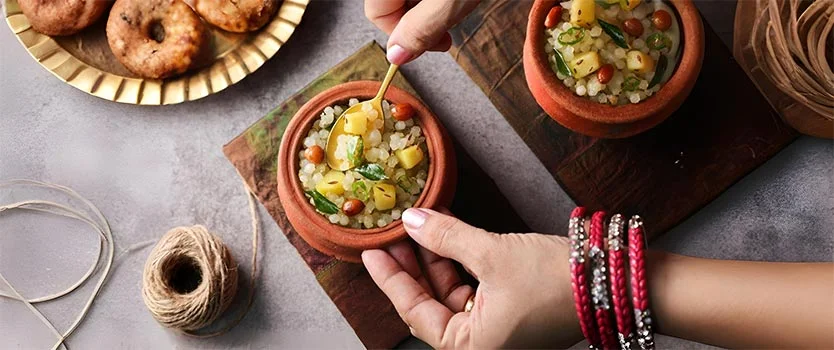Rules of Fasting in Navratri 2025 – What Food to Eat and Avoid

One of the most spiritually lively festivals that is observed in India is Navratri. This is a nine-day festival that is not only about devotion but also about discipline, self-analysis, and reaching into the divine power of goddess Durga. Fasting rules during Navratri can be one of the important activities that contribute to purification of the mind, body, and soul, and bring positivity and blessings in. Knowing how to fast means that your faith is complete and your experience is rich.
Navratri Fasting Laws among Families
Navratri is a family day and a spiritual growth. Observation of the fast by couples and families can help each other, be disciplined, and provide a calm environment at home. The observance of fasting principles as a community boosts the spiritual power and sets up harmony within the relations.
Also Read: 9 Days Shardiya Navratri Puja
Important Rules to follow for Family:
- Make plans and fasting schedules together to make it easy to observe.
- Encourage children to do mini fasts according to their age.
- Undertake evening prayers rituals in order to strengthen family morals.
Day-wise Navratri 9 Days Fasting Rules:
Every day is dedicated to another type of Goddess Durga. It might vary the fasting regulations of each day slightly. By dedicating yourself to Navratri Puja and by following all these daily rules, you will have the most spiritual benefits. It also makes you closely tied to the divine power of the Goddess.
| Days | Goddess | Fasting Rules | Notes |
| Day 1 | Shailaputri | Consume fruits, milk, and satvik food | Eat fruits, milk and satvik food. Begin with new plans and religious prayers. |
| Day 2 | Brahmacharini | Avoid grains; eat kuttu or singhare ke aate dishes | Eat fruits, milk and satvik food. Begin with new plans and religious prayers. |
| Day 3 | Chandraghanta | Light meals, avoid salt if possible | Avoid gains and consume kuttu or singhare aate meals.Pay attention to patience and tranquillity |
| Day 4 | Kushmanda | Simple foods like fruits, milk, and vrat recipes | Light meals, do not take salt where possible. Be courageous and guarded with meditation. |
| Day 5 | Skandamata | Satvik diet: Avoid onions and garlic | Basic dishes such as fruits, milk, and vrat recipes. Keep a positive mind and vitality. |
| Day 6 | Katyayani | Limited meals with vrat ingredients | Pray for wealth and luxury, and happiness in life |
| Day 7 | Kaalratri | Consume fruits, vrat flours, and milk | Satvik diet: Onions and garlic to be avoided. Enhance family relationships and loyalty. |
| Day 8 | Mahagauri | Light meals; focus on purity | Light meals; focus on purityMeditate and practice spirituality. |
| Day 9 | Siddhidatri | Simple food with fast-grain | You can consume fruits, vrat flours, and milk products. Keep your head clear and do not get distracted. |
These daily fasting regulations are not only the reverence of the Goddess but also control of your routine, food, and power throughout the nine days.
Procedure of Navratri Fasting Step-by-step
Fasting is not just about not taking food. It is a religious practice that man cleanses the mind, body, and soul. Through a straightforward process, you are able to stay healthy, effective, and spiritual.
Step-by-Step Procedure:
- Wake up early and take a bath.
- Prepare a clean altar having goddess Durga idols.
- Do morning prayers using mantras and flowers.
- Take satvik food according to fasting.
- Be devoted and have good thoughts, no arguments.
- Close the day with evening prayers and diyas.
To get advice, you may consult with astrologers to ensure auspicious (subh) times to perform rituals.
Advantages of Navratri Vrat Rules
It not only has great spiritual and cultural advantages but also rituals when it comes to observing Navratri fasts. Connecting to these rules, followers feel their minds are clear, they feel peaceful and have better cultural ties.
Key Benefits:
- Enhances self-control and concentration of mind.
- Rifles the family connection and their service loyalty.
- Adopt a healthy and good lifestyle
- Relates to the energy and the positive vibrations of God.
Navratri fasts have a cultural importance, which gives meaning to the daily routine, reminding us of the tradition and spiritual development.
Types of Navratri Fasts
The followers are able to select the types of fasting depending on their health, lifestyles, and the level of devotion.
Falahar Fast: Do not consume any grains or regular food; take fruits and milk only.
Partial Fast: Have satvik meals two times a day; grains and salt should be avoided.
Nirjala Vrat: The most difficult fast, involving not taking both food or water. This fast usually lasts for a single day and requires extreme self-discipline.
Choosing the appropriate kind of fast is a way of making sure that you do not ruin your health or break your devotion during the process of observing Navratri.
Also Read: Shardiya Navratri 2025: Rituals, Meaning
What food should be taken during the Navratri fast?
It is important to keep the energy during fasting. You will have a Classification of delicious vrat foods that would please the stomach but are not in violation of fasting protocols.
Foods Allowed:
- Fruits and milk
- Dishes of samak rice, kuttu and singhara flour.
- Satvik vegetables such as pumpkin, potatoes and pumpkin seeds.
- Dry fruits, nuts, and herbal teas.
Dietitian’s Recommendation
Fasting is significant, even in nutrition. Dietitians recommend that one should drink enough fluids, fruits, and proteins to be active and healthy during the Navratri.
Diet Tips:
- Consume a lot of water or coconut water.
- Add dry fruits in order to provide immediate energy.
- Heavy, oily, or fried foods should be avoided to avoid laziness.
Balanced fasting food is good so that your spiritual life will not compromise your physical life.
Conclusion
Navratri fasting is an ideal combination of religious worship, health, and cultural affiliation. When you observe the right fasting policies, learn the rituals daily and eat healthy, your Navratri experience will become a spiritual journey.
Frequently Asked Questions?
Yes, one can sleep on Navratri fasting. Simply ensure that you are up early, taking prayers and puja.
Non-veg food, alcohol, onion, garlic, and wheat or rice grains should not be taken during Navratri.
Yes, you have 4 days to fast in case you are unable to fast the 9 days. A large number of followers select certain days such as Ashtami or Navami.
It is preferable to fast after sunset or puja. It is not traditional to break after 12 am.
Individuals fast to cleanse the body, curb desires and obtain the blessings of Goddess Durga during Navratri.








